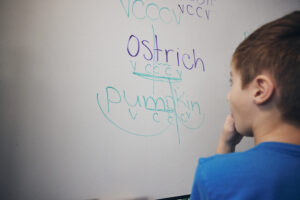Natalie Stapert, K-12 Master Reading Coordinator 2024
Orton Gillingham: Beneficial for All but Vital for Some
Orton-Gillingham is a structured, explicit approach to teaching reading, writing, and spelling, and was specifically designed to support individuals with dyslexia and other language-based learning disabilities. So why is it an integral part of reading instruction for all our students? Its benefits extend to a wide range of learners, making it a valuable educational tool in diverse classrooms, and is part of our ongoing philosophy of providing high-quality instruction that is beneficial to all.
Key Features of Orton-Gillingham Instruction
 An Emphasis on Phonological Awareness: Students practice combining individual sounds into words and breaking words apart into their individual sounds. They also play with words, trying to add, delete, or change some of the sounds in a given word. These skills lay the foundation for effective reading and spelling.
An Emphasis on Phonological Awareness: Students practice combining individual sounds into words and breaking words apart into their individual sounds. They also play with words, trying to add, delete, or change some of the sounds in a given word. These skills lay the foundation for effective reading and spelling.
Structured and Sequential Learning: Orton-Gillingham uses a structured, sequential approach to teaching language skills based on the Science of Reading. The Science of Reading is a body of educational research that describes the best and most effective way to ensure reading succcess for all students.
Preventative Approach: While Orton-Gillingham is often associated with remediation for struggling readers, it can also be used preventatively to build a strong foundation in literacy. Some students have tremendous early success with reading because a strong memory allows them to remember and recognize the most common words, but they struggle with fluency and vocabulary in middle and high school because they do not have phonetic strategies for sounding out the new words they encounter in advanced texts. Teaching all students these skills can help prevent reading difficulties from arising.
Inclusivity: Using Orton-Gillingham in the classroom creates an inclusive environment where all students, regardless of their learning profiles, can benefit from evidence-based instructional methods. It ensures that no one is left behind.
Improved Reading Proficiency: Teaching reading using Orton-Gillingham methods can lead to improved reading proficiency in all students, including those who are experiencing early success in reading. This not only benefits their academic performance but also fosters a lifelong love of reading.
Enhanced Spelling and Writing Skills: Orton-Gillingham also helps students develop strong spelling and writing skills, which are valuable across subjects and in real-world situations.
Build Confidence: The structured and supportive nature of Orton-Gillingham instruction can boost students’ confidence in their ability to read and write, which is essential for academic success and personal growth. As they learn and grow, students are able to shift from a fixed mindset (“I am bad at this”) to a growth mindset (“I can practice and improve”). This shift in mindset is not only helpful in reading, but also in other academic areas and in life outside of school.
Interested in learning more about reading instruction at McLean School? Email admission@mcleanschool.org to set up a conversation or tour.